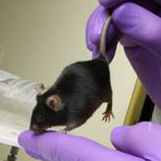Archived Content
The National Institute of Mental Health archives materials that are over 4 years old and no longer being updated. The content on this page is provided for historical reference purposes only and may not reflect current knowledge or information.
Different Genes, Same Risk Pathway in Schizophrenia
• Science Update
Findings linking two biological mechanisms known to play a role in mental illness demonstrate how unrelated genes can work through effects on a common pathway. Many genes contribute to risk of schizophrenia; this work helps illuminate this complex pathway, a potential target for development of future medications.
Background
By identifying genes that underlie mental illness, scientists hope not only to be able to identify people at risk, but to understand how genes alter brain function to make a person vulnerable to illness.
Complementing the search for risk genes, investigators are also identifying how signaling processes in the brain are disrupted in mental illness. Prior research has established that in schizophrenia, there is a disruption in signaling involving the neurotransmitter glutamate. Drugs that block receptors for glutamate cause schizophrenia-like behavior. The chain of molecular events that enables glutamate signaling, however, is complex, and genes associated with schizophrenia risk could have an impact at many different steps in this pathway. A risk gene associated with schizophrenia, depression, and bipolar disorder has been the object of much research since it was discovered in 2000: The Disrupted-in-Schizophrenia-1 (DISC1) gene.
This Study

NIMH-supported scientists at the Johns Hopkins University School of Medicine, led by Mikhail V. Pletnikov, in collaboration with the laboratory of Solomon H. Snyder, explored whether DISC1 might have an impact on a molecule that plays a role in glutamate signaling—D-serine. There is evidence for a connection between D-serine and schizophrenia; in people with the disease, the level of D-serine is reduced and mutations in the gene for an enzyme that produces D-serine have been associated with schizophrenia. D-serine is found largely in cells called glia that surround and support neurons. Earlier work on DISC1 focused primarily on neurons, not glia. Findings in recent years, however, have suggested that these support cells, like the neurons themselves, are involved in the signaling that takes place in the brain.
The investigators found that normal DISC1 protein helps maintain normal levels of D-serine by binding to an enzyme that produces it, while mutant DISC1 protein does not. The result is lower levels of D-serine and reduced signaling involving glutamate and its receptor. To study the relationship between DISC1 and D-serine, the investigators developed a line of transgenic mice carrying a mutant form of the DISC1 gene that could be switched on or off in the type of glial cell that is the main source of D-serine. Adult mice in which the mutant DISC1 has been active throughout life show behavioral abnormalities typical of reduced glutamate signaling and suggestive of schizophrenia. Giving mutant mice D-serine reversed to some extent the behavioral abnormalities caused by the mutation. These results show that at least part of the impact of DISC1 on glutamate synaptic transmission is through its actions in glia on the D-serine pathway—the components of which are encoded by other genes.
Significance
Mental illnesses are genetically complex, with many different genes potentially contributing to risk, each individually having a small (and difficult to detect) impact. This work illustrates the variability of the genetic and biological underpinnings of mental illnesses. The vulnerability of any two people with a similar diagnosis may be the result of a different set of risk genes affecting a common pathway. Identifying the cascade of processes involved in pathways that shape disease risk—and in which numerous genes are involved at different steps—can clarify how individual genes raise or lower risk, and can provide a focus for development of future therapeutics.
The authors point out that, in the mice with mutant DISC1, D-serine levels were only altered at a very early stage of development. While subsequent levels were more normal, the early deficit was enough to alter later behavior. Mental illnesses are increasingly understood to be diseases of development, and this finding helps provides an example of how an early transient deficit might nonetheless have lasting effects.
Finally, the work offers new details on the interplay between neurons and glia in brain signaling, neurodevelopment, and mental illness. “Abnormalities in glia cells could be as important as abnormalities in neuronal cells themselves,” says Pletnikov. “Most gene work has been done with neurons. But we also need to understand a lot more about the role that genetic mutations in glia cells play because neuron-glia interaction appears crucial in ensuring the brain operates normally.”
This work was supported in part by funds from the American Recovery and Reinvestment Act.
Reference
Ma TM, Abazyan S, Abazyan B, Nomura J, Yang C, Seshadri S, Sawa A, Snyder SH, Pletnikov MV. Pathogenic disruption of DISC1-serine racemase binding elicits schizophrenia-like behavior via D-serine depletion. Molecular Psychiatry. 2012 Jul 17. doi: 10.1038/mp.2012.97. [Epub ahead of print]
